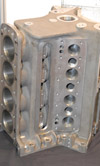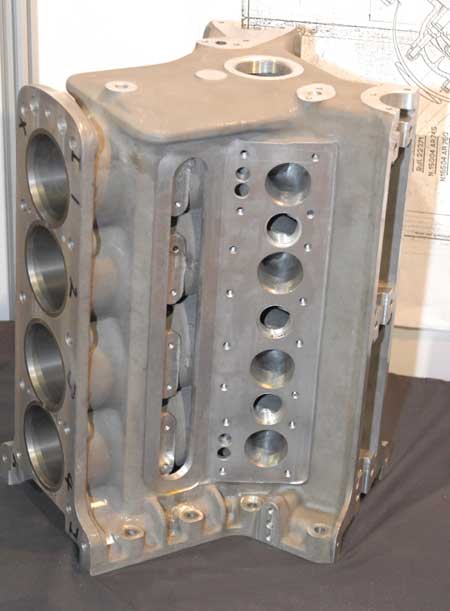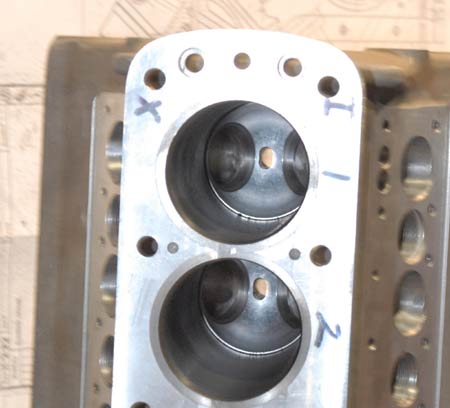The monobloc engine
 Isn't it strange to think that what we regard today as being 'obvious' wasn't quite so obvious in the early days of race engine design. Take the head gasket, for instance. Today's young engineers are almost conditioned to think in terms of separate castings for the combustion chamber and valves, and that of the cylinder-supporting structure. But in days gone by, the very idea of having separate components bolted together with apertures where engine coolant, oil and combustion gas crossed must have been totally unthinkable.
Isn't it strange to think that what we regard today as being 'obvious' wasn't quite so obvious in the early days of race engine design. Take the head gasket, for instance. Today's young engineers are almost conditioned to think in terms of separate castings for the combustion chamber and valves, and that of the cylinder-supporting structure. But in days gone by, the very idea of having separate components bolted together with apertures where engine coolant, oil and combustion gas crossed must have been totally unthinkable.
A visit to the Race Retro exhibition at Stoneleigh in the UK brought this home to me recently when examining the handiwork on one of the historic engine exhibits. At this, the Mecca of the historic racing world, vintage engine manufacturer Jim Stokes showed his latest racing recreation - a 2.7 litre star straight eight of the type fitted to the Alfa Romeo Tipo B, otherwise known as the famous Alfa Romeo P3.
An inline eight-cylinder unit made from two, four-cylinder cast-iron blocks with camshaft and supercharger drive coming from a central gear train, the most noticeable aspect of this engine was the combined structure of the cylinder heads and cylinder block in a single casting. Splitting the engine between cylinder block and crankcase, rather than between cylinder head and cylinder block, allows the complicated and therefore potentially unreliable head gasket to be replaced by a simpler sealing arrangement at the crankcase cylinder block interface. In this particular design the cylinder walls were formed by dry steel liners inserted from the bottom, shrunk into position and retained via a small flange against the top of the crankcase.

Apart from the deletion of the head gasket from the bill of materials, one major design advantage should be better cooling towards the top of the cylinder liner, as well as the complete absence of distortion as a result of the omission of clamping bolts and the high strains that would otherwise be introduced.
The downside, apart from the difficulty of manufacture in the first place, is the inability to service the valves and valve seats easily. At the time, this would surely have been a major handicap, involving the removal of the engine and a complete strip-down to remove crankshaft and pistons assemblies. As so very often happens in engine design, overcoming one particular hazard is likely to introduce many more of a different type. And even now, simply retouching the 16 valves (this engine was only two valves per cylinder) each inclined at 52º to the vertical is reputed to take somewhere near 40 man-hours of work!

But of course the Alfa wasn't the last engine to use this type of construction. Indeed, apart from many early Grand Prix engines (for example Peugeot, Bugatti and Delage), integral head-block designs were often used well into the 1950s, at which time more reliable mechanical seals were developed. Even in the 1980s, engine designer Brian Hart introduced such a design with a 1.5 litre turbo unit used in Formula One.
It may be the cause of many a headache for some over the years but eliminating the head gasket at the design stage can unleash a whole new set of migraine pain for others.
Fig. 1 - Alfa monobloc casting
Fig. 2 - Alfa monobloc - combustion chamber viewed through the cylinder block
Written by John Coxon